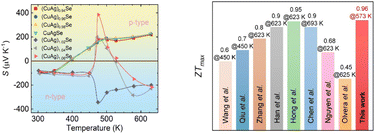Vacancy controlled n–p conduction type transition in CuAgSe with superior thermoelectric performance†
Abstract
As one kind of superionic conductor, CuAgSe is a promising thermoelectric material due to its extremely low thermal conductivity and high electron mobility. In this study, the electrical and thermal properties of CuAgSe were collaboratively optimized by changing the chemical composition. Seebeck coefficient measurements reveal that stoichiometric and CuAg-deficient CuAgSe materials show n–p transition with the increase of temperature. In contrast, the Se-deficient CuAgSe still shows n-type conduction in the α-phase at high temperatures. Positron annihilation measurements indicate that there are large amounts of cation vacancies such as Ag and Cu vacancies in the stoichiometric and CuAg-deficient samples, which provide a high concentration of hole carriers and are responsible for the n–p transition at high temperatures. The number of vacancies decreases gradually with increasing CuAg content, and in the Se-deficient CuAgSe, VAg–Se divacancies are formed, which further results in a sufficient decrease of hole carriers. As a result, the Se-deficient samples still show n-type conduction in the α phase. Our results indicate that vacancy defects are the key factors that determine the conduction type in CuAgSe, which can be tuned by the chemical composition. In addition, superb thermoelectric performance was achieved in both p-type and n-type CuAgSe, with maximum ZT of 0.96 at 573 K in (CuAg)0.96Se (p-type) and 0.55 at 630 K in (CuAg)1.02Se and (CuAg)1.04Se (n-type).

- This article is part of the themed collection: 2023 Journal of Materials Chemistry A HOT Papers


 Please wait while we load your content...
Please wait while we load your content...